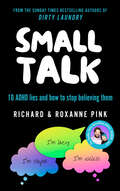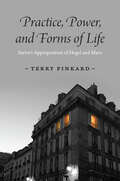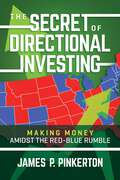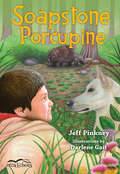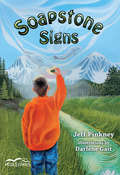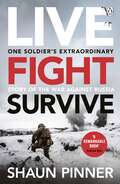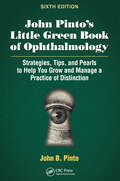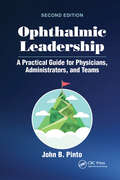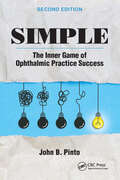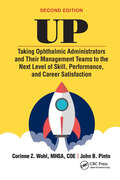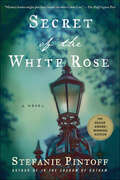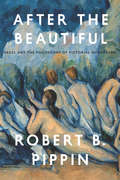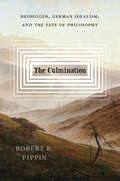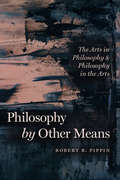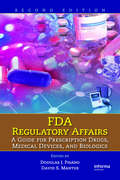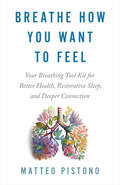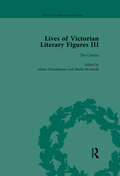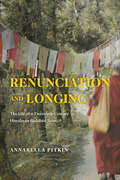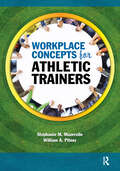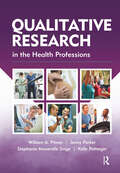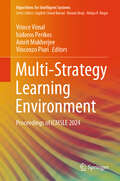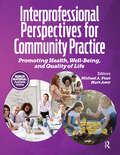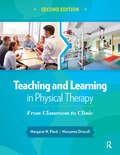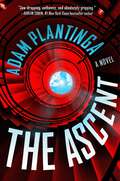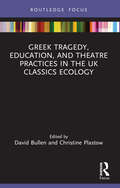- Table View
- List View
Small Talk: 10 ADHD Lies and How to Stop Believing Them
by Richard Pink Roxanne PinkThe beloved authors of Dirty Laundry break down the harmful stereotypes about people with ADHD to help you stop being your worst fear-leader, start bigging yourself up, and live your best neurodivergent life. When &“ADHD wife&” Roxanne Pink and neurotypical husband Richard Pink asked their community of 2.5 million what the biggest ADHD struggle is, the thousands of replies changed everything. As they learned, the real enemy isn&’t productivity or focus, but the toxic ADHD core beliefs we&’ve internalized. With candor and kindness, they share personal stories to highlight and reframe the 10 big lies that ADHD people believe about themselves. From &“I am lazy&” to &“Everybody hates me&” and &“I quit everything I start,&” Small Talk will empower ADHDers and those who love them to navigate life with compassion, humor, and hope. Whether you were diagnosed early or are new to the neurospicy community, Small Talk will change your relationship with yourself and others. Learn how to:• Identify your limiting ADHD beliefs• Break free from neurotypical standards• Support and understand your ADHDers• Adopt a self-kindness mindset• Communicate your needs & boundaries• Celebrate the joys of ADHD
Practice, Power, and Forms of Life: Sartre’s Appropriation of Hegel and Marx
by Terry PinkardPhilosopher Terry Pinkard revisits Sartre’s later work, illuminating a pivotal stance in Sartre’s understanding of freedom and communal action. Jean-Paul Sartre’s Critique of Dialectical Reason, released to great fanfare in 1960, has since then receded in philosophical visibility. As Sartre’s reputation is now making a comeback, it is time for a reappraisal of his later work. In Practice, Power, and Forms of Life, philosopher Terry Pinkard interprets Sartre’s late work as a fundamental reworking of his earlier ideas, especially in terms of his understanding of the possibility of communal action as genuinely free, which the French philosopher had previously argued was impossible. Pinkard reveals how Sartre was drawn back to Hegel, a move that was itself incited by Sartre’s newfound interest in Marxism. Pinkard argues that Sartre constructed a novel position on freedom that has yet to be adequately taken up and analyzed within philosophy and political theory. Through Sartre, Pinkard advances an argument that contributes to the history of philosophy as well as key debates on action and freedom.
The Secret of Directional Investing: Making Money Amidst the Red-Blue Rumble
by James P. PinkertonTo know the trend, spot the trend, or shape the trend is to make money.The trend is your friend—investors know that. But the biggest money comes from the biggest events. The more delta, the more alpha.In that spirit, The Secret of Directional Investing offers a new way of thinking about investing, steeped in culture and history. Focusing on megatrends, this book points out ways to profit from an understanding of two kinds of trends: those that can be spotted, and those that can be shaped. There&’s money in both. The Romans weren&’t kidding when they said, Audentes Fortuna luvat—Fortune favors the bold. The Secret of Directional Investing is a bold look at investments and potential investments.
Soapstone Porcupine (Orca Echoes)
by Jeff PinkneyThe dog shows up the way snow does on a winter's day. She just drifts in and stays, becoming the friend of a young Cree boy. The boy and the dog set out on an adventure that ends in a quandary involving quills and a big brother who swears to take revenge on the porcupine. But Lindy, a Cree elder and master carver, reminds the brothers of the importance of the great porcupine. After a day spent carving in town, the boy learns some truths about human nature and realizes that sometimes, like the porcupine, you must put your quills up to keep from getting pushed around. Soapstone Porcupine is the second book, after Soapstone Signs, narrated by a young Cree boy. The epub edition of this title is fully accessible.
Soapstone Signs (Orca Echoes)
by Jeff PinkneyOne spring, a nine-year-old Cree boy is visited by a master soapstone carver named Lindy, who gives him four pieces of soapstone. The primary secret to carving, the boy learns, is recognizing that each piece of soapstone already holds its true form inside. Lindy teaches the boy to listen to the soapstone and look to the world around him for signs as to what to carve. As the seasons change, the young boy’s experiences lend him opportunities to develop his carving skills and become attuned to the signs around him. He eagerly awaits the following spring, which will bring Lindy’s return and a chance to show off his carvings. The epub edition of this title is fully accessible.
Live. Fight. Survive.: An ex-British soldier’s account of courage, resistance and defiance fighting for Ukraine against Russia
by Shaun PinnerREAD FORMER BRITISH ARMY SOLDIER SHAUN PINNER’S EXTRADORDINARY FIRST-HAND ACCOUNT OF THE WAR IN UKRAINEFor fans of Bravo Two Zero, Touching the Void, and No Way Out‘A hell of a story’ Sgt Dan Mills, Sniper One‘A remarkable book’ Andrew Marr----‘Live. Fight. Survive,’ she said. So, he did . . .There are just two places Shaun Pinner has felt most at home: first, during his nine years in the British Army and, second, in Ukraine, where he settled after marrying. It was only natural then, that when Russia invaded Ukraine in 2022, he was on the front line leading a section of marines.Outnumbered and outgunned, Pinner's troops staged a fighting retreat to Mariupol for that remarkable, defiant last stand against Putin’s war machine. But this was just the beginning of Shaun’s ordeal. When his troops were ambushed, Shaun was captured – and his war shifted from the battlefield to the interrogation room, when the real fight for survival began . . .---‘A remarkable story from the frontline. Extraordinary descriptions [of] what it's actually like to be in a trench fighting in the winter on the front line against the Russians’ ANDREW MARR‘An extraordinary real-life story’ ENTERTAINMENT FOCUS‘I was mesmerised. Unforgettable’ COLONEL RICHARD KEMP, CO-AUTHOR OF ATTACK STATE RED
John Pinto’s Little Green Book of Ophthalmology: Strategies, Tips and Pearls to Help You Grow and Manage a Practice of Distinction
by John B. PintoThe classic reference text for surgeons and managers alike that has been improving ophthalmic practices for decades, John Pinto’s Little Green Book of Ophthalmology: Strategies, Tips, and Pearls to Help You Grow and Manage a Practice of Distinction, Sixth Edition, has been updated into a new edition. Author John B. Pinto, a world-renowned expert on the business of ophthalmic practice, has brought his decades of expertise to bear in this comprehensive guide to practice management. Inside, Pinto covers everything from the basics of business planning to esoteric and complex topics unique to ophthalmology. Topics include: Strategic business planning Leadership, governance, and discipline Finance, accounting, and patient accounts management Staff evaluation, training, and supervision Marketing and development Managing physicians Operations enhancement Facility design and management Improving an optical dispensary This Sixth Edition features updates and edits throughout the book as well as 9 new appendices covering the latest trends and advice in ophthalmic administration. It is also designed in a flexible format, allowing readers to read it straight through, or just hunt down advice on the focused problems facing their practice. As the business of ophthalmology continues to change, the proven guidance of John Pinto’s Little Green Book of Ophthalmology, Sixth Edition, will help any practice adapt and thrive.
Ophthalmic Leadership: A Practical Guide for Physicians, Administrators, and Teams
by John B. PintoOphthalmic practices have many types of leaders, functioning at all levels of the organization. Ophthalmic Leadership: A Practical Guide for Physicians, Administrators, and Teams, Second Edition can provide each of these leaders with the tools to be more decisive, motivating, and effective.John B. Pinto, America’s most published author on the business of ophthalmology, has firsthand experience with the best and worst practice leadership habits from his decades of experience as an ophthalmic practice consultant. He has coached countless physician and lay leaders to the next level of their careers. Together with his team of more than 20 expert contributors, Pinto covers every aspect of leadership in ophthalmology, no matter the size of the practice or the current experience of the team.Chapters include: What Do You Believe in? Developing a List of Core Values for Your Practice Grooming and Moving Line Staff Up to Middle Management Contingency Planning in a Less-Certain Environment Leading Your Team Past the Inevitable Conflicts of Practice Life Everyone in ophthalmology can benefit from the lessons inside Ophthalmic Leadership: A Practical Guide for Physicians, Administrators, and Teams, Second Edition—from the rising ophthalmic technician or department manager, to the managing partner, and even the most seasoned practice administrator.“The book you now hold is a wonderful opportunity to rededicate yourself to your professional development as a leader and to the success of your organization.”From the Foreword by Richard L. Lindstrom, MD
Simple: The Inner Game of Ophthalmic Practice Success
by John B. PintoNow in its Second Edition, Simple: The Inner Game of Ophthalmic Practice Success makes even the most complex issues in ophthalmic practice management just that- simple. This handy guide covers everything from the basics of business planning to esoteric and complex topics unique to ophthalmology.Author John B. Pinto, a world-renowned expert on the business of ophthalmic practice, has brought his decades of expertise to bear in this high-yield handbook. Throughout his career he has seen that the most successful practices large or small have learned to see the big picture and keep things simple. This book helps practice owners, managers, and administrators achieve that goal.Simple cuts through the details and the minutia of running a practice to refocus on the big picture and the key, high-impact factors influencing ophthalmic practice success. Each chapter addresses a new topic, pointing out stumbling blocks and key areas to focus on so practice owners and managers can stick to their strategic goals. With a foreword by Dr. Richard Lindstrom and hundreds of management pearls throughout, Simple: The Inner Game of Ophthalmic Practice Success, Second Edition takes the guesswork out of running an ophthalmic practice. From data analytics to the ins and outs of administration, John B. Pinto makes practice management simple.
UP: Taking Ophthalmic Administrators and Their Management Teams to the Next Level of Skill, Performance and Career Satisfaction
by John B. Pinto Corinne WohlLike having an expert mentor in your pocket, UP is a powerful, practical workbook designed to take ophthalmic administrators and practice managers to the next level of their careers, offering practical tips, concrete advice, and a step-by-step guide for any hurdle they face. Authors Corinne Wohl and John Pinto are undisputed experts in the field, having decades of experience advising ophthalmic practices of all sizes and publishing numerous books and articles on the subject. In this book, Wohl and Pinto guide administrators toward best practices in coaching and developing their entire management team. UP is also a helpful tool for physician leaders (and leaders in training), who can only accomplish their board-level goals through effective lay managers.UP provides readers with: Practical tips on how to create a customized support and development program for each manager and administrator A step-by-step process for better problem solving Worksheets, insightful self-tests, and scorecards for immediate use as part of a linear career development program
Secret of the White Rose: A Novel (Detective Simon Ziele #3)
by Stefanie PintoffStefanie Pintoff's combination of vital characters and a fascinating case set amongst the sometimes brutal and sometimes glittering history of turn-of-the-century New York makes for totally compelling reading in Secret of the White Rose, the third novel in her Edgar Award–winning series.The murder of Judge Hugo Jackson is out of Detective Simon Ziele's jurisdiction in more ways than one. For one, it's high-profile enough to command the attention of the notorious new police commissioner, since Judge Jackson was presiding over the sensational trial of Al Drayson. Drayson, an anarchist, set off a bomb at a Carnegie family wedding, but instead of killing millionaires, it killed passersby, including a child. The dramatic trial has captured the full attention of 1906 New York City.Furthermore, Simon's assigned precinct on Manhattan's West Side includes the gritty Tenderloin but not the tonier Gramercy Park, which is where the judge is found in his locked town house with his throat slashed on the night before the jury is set to deliberate. But his widow insists on calling her husband's old classmate criminologist, Alistair Sinclair, who in turn enlists Ziele's help. Together they must steer Sinclair's unorthodox methods past a police force that is so focused on rounding up Drayson's supporters that they've all but rejected any other possibilities.
After the Beautiful: Hegel and the Philosophy of Pictorial Modernism
by Robert B. PippinIn his Berlin lectures on fine art, Hegel argued that art involves a unique form of aesthetic intelligibility—the expression of a distinct collective self-understanding that develops through historical time. Hegel’s approach to art has been influential in a number of different contexts, but in a twist of historical irony Hegel would die just before the most radical artistic revolution in history: modernism. In After the Beautiful, Robert B. Pippin, looking at modernist paintings by artists such as Édouard Manet and Paul Cézanne through Hegel’s lens, does what Hegel never had the chance to do. While Hegel could never engage modernist painting, he did have an understanding of modernity, and in it, art—he famously asserted—was “a thing of the past,” no longer an important vehicle of self-understanding and no longer an indispensable expression of human meaning. Pippin offers a sophisticated exploration of Hegel’s position and its implications. He also shows that had Hegel known how the social institutions of his day would ultimately fail to achieve his own version of genuine equality, a mutuality of recognition, he would have had to explore a different, new role for art in modernity. After laying this groundwork, Pippin goes on to illuminate the dimensions of Hegel’s aesthetic approach in the path-breaking works of Manet, the “grandfather of modernism,” drawing on art historians T. J. Clark and Michael Fried to do so. He concludes with a look at Cézanne, the “father of modernism,” this time as his works illuminate the relationship between Hegel and the philosopher who would challenge Hegel’s account of both modernity and art—Martin Heidegger. Elegantly inter-weaving philosophy and art history, After the Beautiful is a stunning reassessment of the modernist project. It gets at the core of the significance of modernism itself and what it means in general for art to have a history. Ultimately, it is a testament, via Hegel, to the distinctive philosophical achievements of modernist art in the unsettled, tumultuous era we have inherited.
The Culmination: Heidegger, German Idealism, and the Fate of Philosophy
by Robert B. PippinA provocative reassessment of Heidegger’s critique of German Idealism from one of the tradition’s foremost interpreters. Heidegger claimed that Western philosophy ended—failed, even—in the German Idealist tradition. In The Culmination, Robert B. Pippin explores the ramifications of this charge through a masterful survey of Western philosophy, especially Heidegger’s critiques of Hegel and Kant. Pippin argues that Heidegger’s basic concern was to determine sources of meaning for human life, particularly those that had been obscured by Western philosophy’s attention to reason. The Culmination offers a new interpretation of Heidegger, German Idealism, and the fate of Western rationalism.
Philosophy by Other Means: The Arts in Philosophy & Philosophy in the Arts
by Robert B. PippinThroughout his career, Robert B. Pippin has examined the relationship between philosophy and the arts. With his writings on film, literature, and visual modernism, he has shown that there are aesthetic objects that cannot be properly understood unless we acknowledge and reflect on the philosophical concerns that are integral to their meaning. His latest book, Philosophy by Other Means, extends this trajectory, offering a collection of essays that present profound considerations of philosophical issues in aesthetics alongside close readings of novels by Henry James, Marcel Proust, and J. M. Coetzee. The arts hold a range of values and ambitions, offering beauty, playfulness, and craftsmanship while deepening our mythologies and enriching the human experience. Some works take on philosophical ambitions, contributing to philosophy in ways that transcend the discipline’s traditional analytic and discursive forms. Pippin’s claim is twofold: criticism properly understood often requires a form of philosophical reflection, and philosophy is impoverished if it is not informed by critical attention to aesthetic objects. In the first part of the book, he examines how philosophers like Kant, Hegel, and Adorno have considered the relationship between art and philosophy. The second part of the book offers an exploration of how individual artworks might be considered forms of philosophical reflection. Pippin demonstrates the importance of practicing philosophical criticism and shows how the arts can provide key insights that are out of reach for philosophy, at least as traditionally understood.
FDA Regulatory Affairs: A Guide for Prescription Drugs, Medical Devices, and Biologics
by Douglas J. Pisano David S. MantusExamines harmonization of the US Federal Food, Drug, and Cosmetic Act with international regulations as they apply to human drug and device development, research, manufacturing, and marketing. The Second Edition focuses on the new drug approval process, cGMPs, GCPs, quality system compliance, and corresponding documentation requirements. Written in
Breathe How You Want to Feel: Your Breathing Tool Kit for Better Health, Restorative Sleep, and Deeper Connection
by Matteo PistonoBreathwork guide and meditation teacher Matteo Pistono offers a how-to book for upgrading your nervous system to live your optimal life physically, emotionally, and spiritually.Do you want to calm your racing thoughts before lying down for a restful night of sleep? Or raise your energy levels before your morning exercise or spin class, and have laser focus before an important meeting? Are you overwhelmed from the flood of information from your social media and news feed? Any time your emotional state is out of balance, there are time-tested, practical methods to breathe your way back into the state of being you want.You have the capacity to change how you feel, in any moment, when you partner with your breath. It&’s a matter of paying attention and then consciously altering your breathing pattern.Too often books on breathing and breathwork coaches do not teach the actual mechanics of breathing. Instead, they guide one-off sessions, teach protocols, or direct you to an app. The consequence of just following a protocol without understanding breathing mechanics leaves the student disempowered and dependent on the teacher. Instead, in Breathe How You Want to Feel, learning functional breathing becomes the basis upon which you gain control of your well-being—it&’s the secret tool behind resiliency.Breathe How You Want to Feel offers you a psychophysical tool kit that includes:· awareness building,· understanding the dials of your nervous system,· the importance of nasal breathing,· how breath holds (even when very short) are a superpower, and· how to integrate optimal breathing throughout your everyday life, especially when you're sleeping.You&’ll use these tools to optimize your breathing to overcome being tired, wired, and uninspired. You&’ll learn how to breathe optimally during your workday, while exercising, when entering meditative and flow states, and for deep rest. And you&’ll partner with your breath to discover deeper meaning in life. This book meets you, the breather, where you are with step-by-step actionable tools to improve your health, sleep, and well-being.
Lives of Victorian Literary Figures, Part III, Volume 2: Elizabeth Gaskell, the Carlyles and John Ruskin
by Ralph Pite Valerie Sanders Aileen Christianson Simon Grimble Sheila A McintoshThomas and Jane Welsh Carlyle moved from rural Scotland to London's Cheyne Walk. This title focuses on writers for whom 'the centre' was a pressing concern. Elizabeth Gaskell, like her contemporary Emily Bronte, was from the north of England, though based in Lancashire and Cheshire rather than Yorkshire. Her first novel, Mary Barton 1848) was set in the north and was unusually realistic in its depiction of Manchester working-class life. Ruskin grew up in suburban London; in later life, he settled in the Lake District . The three volumes that comprise a set are facsimile reproductions of contemporary biographical material. They include letters, memoirs, poems and articles on three outstanding Victorian literary persons: John Ruskin, Elzabeth Gaskell and the Carlyles.
Renunciation and Longing: The Life of a Twentieth-Century Himalayan Buddhist Saint (Buddhism And Modernity Ser.)
by Annabella PitkinThrough the eventful life of a Himalayan Buddhist teacher, Khunu Lama, this study reimagines cultural continuity beyond the binary of traditional and modern. In the early twentieth century, Khunu Lama journeyed across Tibet and India, meeting Buddhist masters while sometimes living, so his students say, on cold porridge and water. Yet this elusive wandering renunciant became a revered teacher of the Fourteenth Dalai Lama. At Khunu Lama’s death in 1977, he was mourned by Himalayan nuns, Tibetan lamas, and American meditators alike. The many surviving stories about him reveal significant dimensions of Tibetan Buddhism, shedding new light on questions of religious affect and memory that reimagines cultural continuity beyond the binary of traditional and modern. In Renunciation and Longing, Annabella Pitkin explores devotion, renunciation, and the teacher-student lineage relationship as resources for understanding Tibetan Buddhist approaches to modernity. By examining narrative accounts of the life of a remarkable twentieth-century Himalayan Buddhist and focusing on his remembered identity as a renunciant bodhisattva, Pitkin illuminates Tibetan and Himalayan practices of memory, affective connection, and mourning. Refuting long-standing caricatures of Tibetan Buddhist communities as unable to be modern because of their religious commitments, Pitkin shows instead how twentieth- and twenty-first-century Tibetan and Himalayan Buddhist narrators have used themes of renunciation, devotion, and lineage as touchstones for negotiating loss and vitalizing continuity.
Workplace Concepts for Athletic Trainers
by William Pitney Stephanie MazerolleAthletic trainers often find themselves immersed in organizations that can critically influence the way in which they fulfill their professional obligations. The workplace can offer many situations that are challenging, particularly for those athletic trainers who are transitioning into clinical practice.With that in mind, Workplace Concepts for Athletic Trainers provides readers with clear and meaningful information that addresses common concepts and issues that occur in the workplace. The topics selected are a reflection of those covered in the literature as problematic yet identifiable and manageable. Each chapter begins with learning objectives and includes a discussion of the issue itself, how it manifests (sources and antecedents), and strategies and solutions to address the concern.Inside Workplace Concepts for Athletic Trainers, Drs. Stephanie M. Mazerolle and William A. Pitney have infused each chapter with case studies to help readers apply the information presented. The conclusion of each chapter contains a summary, questions for review, and suggested readings to reinforce learning. The recommendations and information presented are designed to improve the workplace culture and climate and provide readers with practical suggestions for dealing with workplace issues.Included with the text are online supplemental materials for faculty use in the classroom.Workplace Concepts for Athletic Trainers is a must-have for any athletic training student transitioning into clinical practice or a clinician seeking help for common issues that occur in the workplace.
Qualitative Research in the Health Professions
by William Pitney Jenny Parker Stephanie Mazerolle Kelly PotteigerQualitative research can provide a great depth of understanding for health professionals in practice. Although many general research texts used in health discipline research courses present a broad spectrum of research methods, their discussion of qualitative methods is often limited. Qualitative Research in the Health Professions by Drs. William A. Pitney, Jenny Parker, Stephanie M. Mazerolle, and Kelly Potteiger, is a practical and straightforward text for those learning about qualitative research in the health professions. In Qualitative Research in the Health Professions, readers will acquire skills in mastering:• Introductory concepts of qualitative research, how it compares to quantitative research, and how to conceptualize a qualitative study • How to conduct a qualitative research study and present findings, including sections on collecting and analyzing data, ensuring trustworthiness of the data, and attending to ethical issues • Advanced concepts including various forms of qualitative research, how to mix quantitative and qualitative methods, and how to evaluate qualitative research Each chapter includes activities and exercises to further students’ understanding and the text also includes personal commentaries from scholarly practitioners in various health professions underscoring the value and importance of qualitative research. Qualitative Research in the Health Professionswill help current and future practitioners master the principles of qualitative research, understand published qualitative studies, and apply these findings in furthering evidence-based practice.
Multi-Strategy Learning Environment: Proceedings of ICMSLE 2024 (Algorithms for Intelligent Systems)
by Vincenzo Piuri Isidoros Perikos Vrince Vimal Amrit MukherjeeThe book presents selected papers from International Conference on Multi-Strategy Learning Environment (ICMSLE 2024), held at Graphic Era Hill University, Dehradun, India, during 12–13 January 2024. This book presents current research in machine learning techniques, deep learning theories and practices, interpretability and explainability of AI algorithms, game theory and learning, multi-strategy learning (MSL) in distributed and streaming environments, and adaptive data analysis and selective inference.
Interprofessional Perspectives for Community Practice: Promoting Health, Well-Being, and Quality of Life
by Michael Pizzi Mark AmirNow more than ever health care professionals play an increased role in the promotion of health to populations. Unique and innovative, Interprofessional Perspectives for Community Practice: Promoting Health, Well-being and Quality of Life weaves everyday care into prevention, community, and population health, creating a new and more expansive vision of health for all without compromising traditional practices.Authors and editors Drs. Pizzi and Amir discuss and illustrate a client-centered preventive and health, well-being and quality of life approach rooted in best practice principles from interprofessional literature and firsthand experience. The text illustrates how allied health professionals implement those principles in their everyday and traditional practices with an emphasis on exploring health and well-being issues. Interprofessional Perspectives for Community Practice provides detailed guidance in program development and implementation.What’s included in Interprofessional Perspectives for Community: Clinical anecdotes on successful community practices A focus on primary and secondary prevention Assessments, interventions, and community practice examples Descriptions of community-based practice settings such as adult day care, independent living programs, hospice, and home health care Health and wellness across the lifespan Bonus chapters available online as PDFs for readers The first text of its kind to weave interprofessionalism, community practice, and health, well-being, and quality of life, Interprofessional Perspectives for Community Practice: Promoting Health, Well-being and Quality of Life is for all health care workers and students who wish to transfer practice skills from the clinical setting to a population-based program development model.
Teaching and Learning in Physical Therapy: From Classroom to Clinic
by Margaret Plack Maryanne DriscollTeaching and Learning in Physical Therapy: From Classroom to Clinic, Second Edition is based on the teaching, research, and professional experiences of Drs. Margaret Plack and Maryanne Driscoll, who together have over 60 years of experience. More importantly it contains practical information that allows students, educators, and clinicians to develop optimal instructional strategies in a variety of settings. Clinical scenarios and reflective questions are interspersed throughout, providing opportunities for active learning, critical thinking, and immediate direct application.Grounded in current literature, the Second Edition is geared for physical therapists, physical therapist assistants, students, educators, and other health care professionals. By extending the principles of systematic effective instruction to facilitate critical thinking in the classroom and the clinic, and providing strategies to enhance communication and collaboration, the Second Edition has a strong theoretical basis in reflective practice, active learning strategies, and evidence-based instruction.Features: A user-friendly approach integrating theory and practical application throughout Classroom/clinical vignettes along with integrative problem solving activities and reflective questions to reinforce concepts Key points to remember and chapter summaries throughout Updated references and suggested readings at the end of each chapter Included with the text are online supplemental materials for faculty use in the classroom.In physical therapy, teaching and learning are lifelong processes. Whether you are a student, clinician, first time presenter, or experienced faculty member, you will find Teaching and Learning in Physical Therapy: From Classroom to Clinic, Second Edition useful for enhancing your skills both as a learner and as an educator in physical therapy.
The Ascent
by Adam PlantingaWhen a high security prison fails, a down-on-his luck cop and the governor&’s daughter are going to have to team up if they&’re going to escape in this "jaw-dropping, authentic, and absolutely gripping" (Harlan Coben, #1 New York Times bestselling author) debut USA Today bestselling thriller from Adam Plantinga, whose first nonfiction book Lee Child praised as &“truly excellent.&” Kurt Argento, an ex-Detroit street cop who can&’t let injustice go—and who has the fighting skills to back up his idealism. If he sees a young girl being dragged into an alley, he's going to rescue her and cause some damage. When he does just that in a small corrupt Missouri town, he&’s brutally beaten and thrown into a maximum-security prison. Julie Wakefield, a grad student who happens to be the governor's daughter, is about to take a tour of the prison. But when a malfunction in the security system releases a horde of prisoners, a fierce struggle for survival ensues. Argento must help a small band of staff and civilians, including Julie and her two state trooper handlers, make their way from the bottom floor to the roof to safety. All that stands in their way are six floors of the most dangerous convicts in Missouri.
Greek Tragedy, Education, and Theatre Practices in the UK Classics Ecology (Classics In and Out of the Academy)
by Christine Plastow David BullenThrough a series of case studies, this book explores the interrelations among Greek tragedy, theatre practices, and education in the United Kingdom. This is situated within what the volume proposes as ‘the Classics ecology’.The term ‘ecology’, frequently used in Theatre Studies, understands Classics as a field of cultural production dependent on shared knowledge circulated via formal and informal networks, which operate on the basis of mutually beneficial exchange. Productions of Greek tragedy may be influenced by members of the team studying Classics subjects at school or university, or reading popular works of Classical scholarship, or else by working with an academic consultant. All of these have some degree of connection to academic Classics, albeit filtered through different lenses, creating a network of mutual influence and benefit (the ecology). In this way, theatrical productions of Greek drama may, in the long term, influence Classics as an academic discipline, and certainly contribute to attesting to the relevance of Classics in the modern world. The chapters in this volume include contributions by both theatre makers and academics, whose backgrounds vary between Theatre Studies and Classics. They comprise a variety of case studies and approaches, exploring the dissemination of knowledge about the ancient world through projects that engage with Greek tragedy, theories and practices of theatre making through the chorus, and practical relationships between scholars and theatre makers. By understanding the staging of Greek tragedy in the United Kingdom today as being part of the Classics ecology, the book examines practices and processes as key areas in which the value of engaging with the ancient past is (re)negotiated.This book is primarily suitable for students and scholars working in Classical Reception and Theatre Studies who are interested in the reception history of Greek tragedy and the intersection of the two fields. It is also of use to more general Classics and Theatre Studies audiences, especially those engaged with current debates around ‘saving Classics’ and those interested in a structural, systemic approach to the intersection between theatre, culture, and class.
